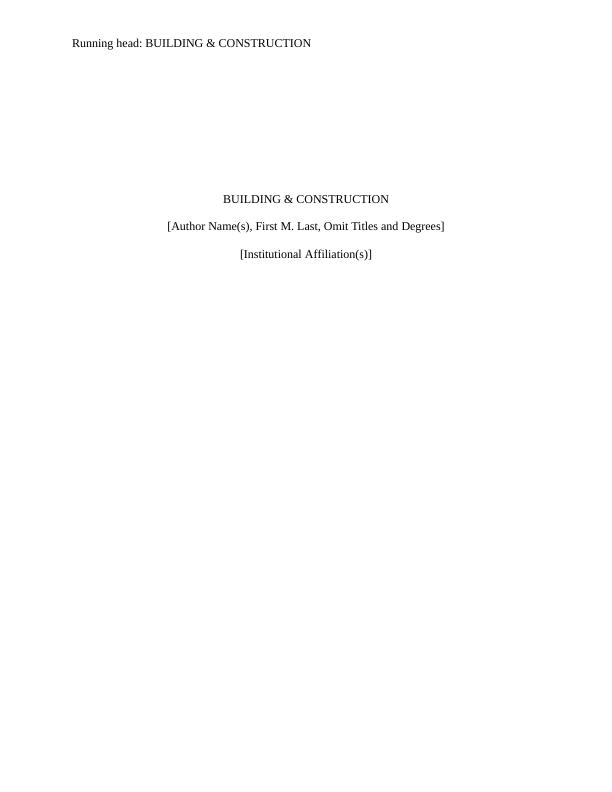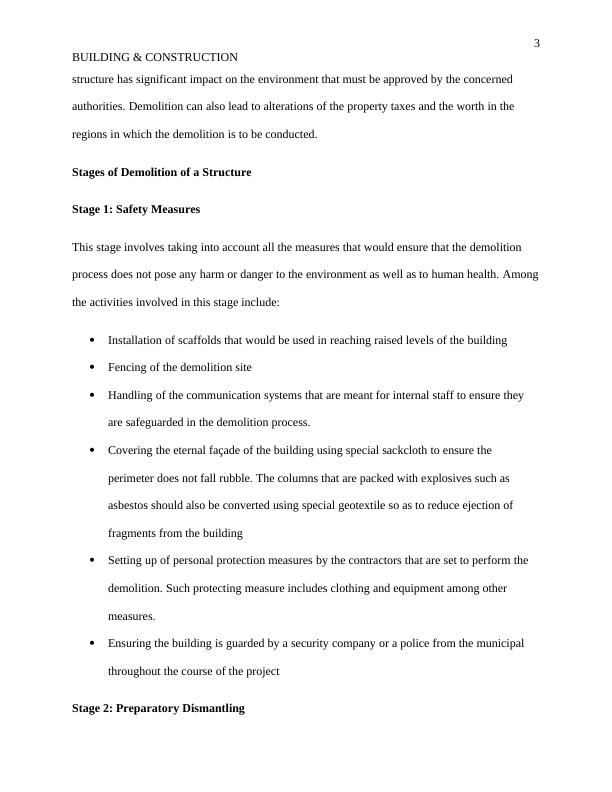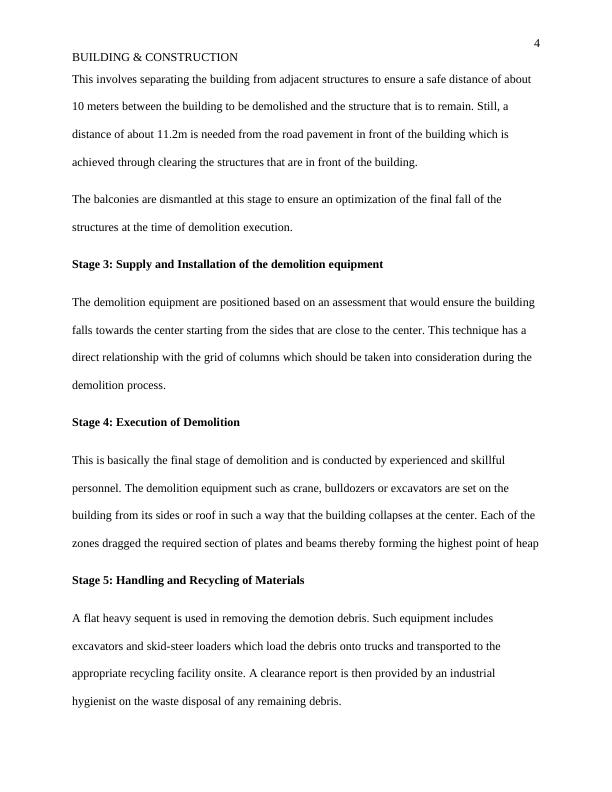Building Construction - Assignment
11 Pages2240 Words19 Views
Added on 2021-06-16
Building Construction - Assignment
Added on 2021-06-16
ShareRelated Documents
Running head: BUILDING & CONSTRUCTION
BUILDING & CONSTRUCTION
[Author Name(s), First M. Last, Omit Titles and Degrees]
[Institutional Affiliation(s)]
BUILDING & CONSTRUCTION
[Author Name(s), First M. Last, Omit Titles and Degrees]
[Institutional Affiliation(s)]

2
BUILDING & CONSTRUCTION
Question 1: Demolition Plan
Numerous steps are involved in the demolition of a dwelling unit or an existing building that
need to be achieved to ascertain that the demolition process remains in line with the stipulated
regulations and guidelines. The demolition steps are as shown:
Assessing the needs-Demolition should address the defined and specific needs in order to
customize the plan of demolition (Ching, 2016). The specific needs should be defined as per
the specific projects as numerous factors and approaches are required in the demolition of a
structure.
Creating a plan-The plan include the method that is to be deployed in carrying out the demolition
besides the equipment that would be adopted in conducting the demolition. The building should
be demolished in such a way that the safest and the most efficient strategy are adopted. The
reasons for demolition, the size of the dwelling unit and the types of construction materials used
determine the plan to be used in the demolition process (Workshop, 2015).
The location of the building as well has a significant role in creating such as plan and such
method as selective demolition, implosion, deconstruction and the conventional excavator with a
grapple can be adopted (Research, 2013). The company is able to make a choice on which
method to adopt upon establishing a plan. The company will as well be able to make decision
and come up with the cost, the equipment to be used, the mode of disposal and the quantity of
the debris. The demolition plan should also encompass emergency plans and back up plans as
part of the whole demolition plan to take charge of any possible eventualities.
Getting Permits-The commencement and execution of a demolition plan requires approvals from
the necessary authorities (Massey, 2011). This is due to the fact that demolition of any
BUILDING & CONSTRUCTION
Question 1: Demolition Plan
Numerous steps are involved in the demolition of a dwelling unit or an existing building that
need to be achieved to ascertain that the demolition process remains in line with the stipulated
regulations and guidelines. The demolition steps are as shown:
Assessing the needs-Demolition should address the defined and specific needs in order to
customize the plan of demolition (Ching, 2016). The specific needs should be defined as per
the specific projects as numerous factors and approaches are required in the demolition of a
structure.
Creating a plan-The plan include the method that is to be deployed in carrying out the demolition
besides the equipment that would be adopted in conducting the demolition. The building should
be demolished in such a way that the safest and the most efficient strategy are adopted. The
reasons for demolition, the size of the dwelling unit and the types of construction materials used
determine the plan to be used in the demolition process (Workshop, 2015).
The location of the building as well has a significant role in creating such as plan and such
method as selective demolition, implosion, deconstruction and the conventional excavator with a
grapple can be adopted (Research, 2013). The company is able to make a choice on which
method to adopt upon establishing a plan. The company will as well be able to make decision
and come up with the cost, the equipment to be used, the mode of disposal and the quantity of
the debris. The demolition plan should also encompass emergency plans and back up plans as
part of the whole demolition plan to take charge of any possible eventualities.
Getting Permits-The commencement and execution of a demolition plan requires approvals from
the necessary authorities (Massey, 2011). This is due to the fact that demolition of any

3
BUILDING & CONSTRUCTION
structure has significant impact on the environment that must be approved by the concerned
authorities. Demolition can also lead to alterations of the property taxes and the worth in the
regions in which the demolition is to be conducted.
Stages of Demolition of a Structure
Stage 1: Safety Measures
This stage involves taking into account all the measures that would ensure that the demolition
process does not pose any harm or danger to the environment as well as to human health. Among
the activities involved in this stage include:
Installation of scaffolds that would be used in reaching raised levels of the building
Fencing of the demolition site
Handling of the communication systems that are meant for internal staff to ensure they
are safeguarded in the demolition process.
Covering the eternal façade of the building using special sackcloth to ensure the
perimeter does not fall rubble. The columns that are packed with explosives such as
asbestos should also be converted using special geotextile so as to reduce ejection of
fragments from the building
Setting up of personal protection measures by the contractors that are set to perform the
demolition. Such protecting measure includes clothing and equipment among other
measures.
Ensuring the building is guarded by a security company or a police from the municipal
throughout the course of the project
Stage 2: Preparatory Dismantling
BUILDING & CONSTRUCTION
structure has significant impact on the environment that must be approved by the concerned
authorities. Demolition can also lead to alterations of the property taxes and the worth in the
regions in which the demolition is to be conducted.
Stages of Demolition of a Structure
Stage 1: Safety Measures
This stage involves taking into account all the measures that would ensure that the demolition
process does not pose any harm or danger to the environment as well as to human health. Among
the activities involved in this stage include:
Installation of scaffolds that would be used in reaching raised levels of the building
Fencing of the demolition site
Handling of the communication systems that are meant for internal staff to ensure they
are safeguarded in the demolition process.
Covering the eternal façade of the building using special sackcloth to ensure the
perimeter does not fall rubble. The columns that are packed with explosives such as
asbestos should also be converted using special geotextile so as to reduce ejection of
fragments from the building
Setting up of personal protection measures by the contractors that are set to perform the
demolition. Such protecting measure includes clothing and equipment among other
measures.
Ensuring the building is guarded by a security company or a police from the municipal
throughout the course of the project
Stage 2: Preparatory Dismantling

4
BUILDING & CONSTRUCTION
This involves separating the building from adjacent structures to ensure a safe distance of about
10 meters between the building to be demolished and the structure that is to remain. Still, a
distance of about 11.2m is needed from the road pavement in front of the building which is
achieved through clearing the structures that are in front of the building.
The balconies are dismantled at this stage to ensure an optimization of the final fall of the
structures at the time of demolition execution.
Stage 3: Supply and Installation of the demolition equipment
The demolition equipment are positioned based on an assessment that would ensure the building
falls towards the center starting from the sides that are close to the center. This technique has a
direct relationship with the grid of columns which should be taken into consideration during the
demolition process.
Stage 4: Execution of Demolition
This is basically the final stage of demolition and is conducted by experienced and skillful
personnel. The demolition equipment such as crane, bulldozers or excavators are set on the
building from its sides or roof in such a way that the building collapses at the center. Each of the
zones dragged the required section of plates and beams thereby forming the highest point of heap
Stage 5: Handling and Recycling of Materials
A flat heavy sequent is used in removing the demotion debris. Such equipment includes
excavators and skid-steer loaders which load the debris onto trucks and transported to the
appropriate recycling facility onsite. A clearance report is then provided by an industrial
hygienist on the waste disposal of any remaining debris.
BUILDING & CONSTRUCTION
This involves separating the building from adjacent structures to ensure a safe distance of about
10 meters between the building to be demolished and the structure that is to remain. Still, a
distance of about 11.2m is needed from the road pavement in front of the building which is
achieved through clearing the structures that are in front of the building.
The balconies are dismantled at this stage to ensure an optimization of the final fall of the
structures at the time of demolition execution.
Stage 3: Supply and Installation of the demolition equipment
The demolition equipment are positioned based on an assessment that would ensure the building
falls towards the center starting from the sides that are close to the center. This technique has a
direct relationship with the grid of columns which should be taken into consideration during the
demolition process.
Stage 4: Execution of Demolition
This is basically the final stage of demolition and is conducted by experienced and skillful
personnel. The demolition equipment such as crane, bulldozers or excavators are set on the
building from its sides or roof in such a way that the building collapses at the center. Each of the
zones dragged the required section of plates and beams thereby forming the highest point of heap
Stage 5: Handling and Recycling of Materials
A flat heavy sequent is used in removing the demotion debris. Such equipment includes
excavators and skid-steer loaders which load the debris onto trucks and transported to the
appropriate recycling facility onsite. A clearance report is then provided by an industrial
hygienist on the waste disposal of any remaining debris.

End of preview
Want to access all the pages? Upload your documents or become a member.
Related Documents
Demolition Plan: Steps, Guidelines, and Regulationslg...
|16
|1794
|289
Demolition Plan for Construction of Factory Units and Office Space in Banksialg...
|17
|4021
|407
Engineering Assignmentlg...
|5
|712
|83
Construction and Building Assignmentlg...
|40
|6766
|220
CPCCBC4010B Apply Structural Principles to Residential Low Rise Constructionslg...
|8
|1733
|245
Future Maintenance of Podium Claddinglg...
|10
|1611
|142
